Distributed Energy Sharing for PVT-HP Prosumers in Community Energy Internet: A Consensus Approach
Abstract
:1. Introduction
- (1)
- The CEI is constructed as a heat and electricity coupled network, in which the PVT-HP prosumers are modelled with four role attributes and heat-electricity DR ability.
- (2)
- A social welfare maximization model is built for the CEI, including PVT-HP prosumers, CHP system, and utility grid. By using Lagrange multiplier method, the problem is further decoupled into three sub-optimization problems correspondingly.
- (3)
- A consensus algorithm is designed to solve the optimization problem of the CEI, which can be fully-distributed solved by each participant in the local market.
2. Structure and Function of CEI
3. Basic Knowledge of Consensus Algorithm
3.1. Graph Theory
3.2. Consensus Protocols
4. System Model
4.1. Profit of Utility Grid
4.2. Utility of Prosumer
4.3. Profit of CHP
5. Problem Formulation and Algorithm
5.1. Optimization Problem
5.2. Problem Decoupling
5.3. Design of Algorithm
| Algorithm 1 Algorithm for participants in the CEI |
|
| Algorithm 2 Iteration Process |
| While true |
|
6. Case Study
6.1. Basic Data
6.2. Results of Simulation
6.2.1. Convergence and Optimality of Consensus Algorithm
6.2.2. Results of Price and Net Power
6.3. Analysis of Computation Time and Applications
7. Conclusions
Author Contributions
Funding
Conflicts of Interest
References
- Rifkin, J. The third industrial revolution: How lateral power is transforming energy, the economy, and the world. Survival 2011, 2, 67–68. [Google Scholar] [CrossRef]
- Wang, K.; Yu, J.; Yu, Y.; Qian, Y.; Zeng, D.; Guo, S.; Xiang, Y.; Wu, J. A Survey on Energy Internet: Architecture, Approach, and Emerging Technologies. IEEE Syst. J. 2017. [Google Scholar] [CrossRef]
- Sabbah, A.I.; El-Mougy, A.; Ibnkahla, M. A Survey of Networking Challenges and Routing Protocols in Smart Grids. IEEE Trans. Ind. Inform. 2013, 10, 210–221. [Google Scholar] [CrossRef]
- Bui, N.; Castellani, A.P.; Casari, P.; Zorzi, M. The internet of energy: a web-enabled smart grid system. IEEE Netw. 2012, 26, 39–45. [Google Scholar] [CrossRef]
- Huang, A.Q.; Crow, M.L.; Heydt, G.T.; Zheng, J.P.; Dale, S.J. The Future Renewable Electric Energy Delivery and Management (FREEDM) System: The Energy Internet. Proc. IEEE 2010, 99, 133–148. [Google Scholar] [CrossRef]
- Huang, A. FREEDM system—A vision for the future grid. In Proceedings of the 2010 IEEE Power and Energy Society General Meeting, Providence, RI, USA, 25–29 July 2010; pp. 1–4. [Google Scholar]
- Ji, Z.; Sun, Y.; Wang, S.; Zhao, J. Design of a three-phase cascaded Power Electronic Transformer based on energy Internet. In Proceedings of the International Conference on Sustainable Power Generation and Supply, Hangzhou, China, 8–9 September 2012; pp. 1–6. [Google Scholar]
- Arnold, M.; Negenborn, R.R.; Andersson, G.; Schutter, B.D. Distributed Predictive Control for Energy Hub Coordination in Coupled Electricity and Gas Networks; Springer: Berlin, Germany, 2010; pp. 235–273. [Google Scholar]
- Rastegar, M.; Fotuhi-Firuzabad, M. Load Management in a Residential Energy Hub with Renewable Distributed Energy Resources. Energy Build. 2015, 107, 234–242. [Google Scholar] [CrossRef]
- Ma, L.; Liu, N.; Wang, L.; Zhang, J.; Lei, J.; Zeng, Z.; Wang, C.; Cheng, M. Multi-party energy management for smart building cluster with PV systems using automatic demand response. Energy Build. 2016, 121, 11–21. [Google Scholar] [CrossRef]
- Liu, N.; Wang, J.; Wang, L. Distributed energy management for interconnected operation of combined heat and power-based microgrids with demand response. J. Mod. Power Syst. Clean Energy 2017, 5, 478–488. [Google Scholar] [CrossRef] [Green Version]
- Liu, N.; Yu, X.; Wang, C.; Li, C.; Ma, L.; Lei, J. Energy-Sharing Model With Price-Based Demand Response for Microgrids of Peer-to-Peer Prosumers. IEEE Trans. Power Syst. 2017, 32, 3569–3583. [Google Scholar] [CrossRef]
- Liu, N.; Chen, Q.; Liu, J.; Lu, X.; Li, P.; Lei, J.; Zhang, J. A Heuristic Operation Strategy for Commercial Building Microgrids Containing EVs and PV System. IEEE Trans. Ind. Electron. 2015, 62, 2560–2570. [Google Scholar] [CrossRef]
- Radziemska, E. The effect of temperature on the power drop in crystalline silicon solar cells. Renew. Energy 2003, 28, 1–12. [Google Scholar] [CrossRef]
- He, W.; Chow, T.T.; Ji, J.; Lu, J.; Pei, G.; Chan, L.S. Hybrid photovoltaic and thermal solar-collector designed for natural circulation of water. Appl. Energy 2006, 83, 199–210. [Google Scholar] [CrossRef]
- Huang, B.J.; Lin, T.H.; Hung, W.C.; Sun, F.S. Performance evaluation of solar photovoltaic/thermal systems. Sol. Energy 2014, 70, 443–448. [Google Scholar] [CrossRef]
- Putrayudha, S.A.; Kang, E.C.; Evgueniy, E.; Libing, Y.; Lee, E.J. A study of photovoltaic/thermal (PVT)-ground source heat pump hybrid system by using fuzzy logic control. Appl. Therm. Eng. 2015, 89, 578–586. [Google Scholar] [CrossRef]
- Tsai, H.L. Modeling and validation of refrigerant-based PVT-assisted heat pump water heating system. Sol. Energy 2015, 122, 36–47. [Google Scholar] [CrossRef]
- Emmi, G.; Tisato, C.; Zarrella, A.; Carli, M.D. Multi-Source Heat Pump Coupled with a Photovoltaic Thermal (PVT) Hybrid Solar Collectors Technology: a Case Study in Residential Application. Int. J. Energy Prod. Manag. 2016, 1, 382–392. [Google Scholar]
- Bertram, E.; Glembin, J.; Rockendorf, G. Unglazed PVT collectors as additional heat source in heat pump systems with borehole heat exchanger. Energy Procedia 2012, 30, 414–423. [Google Scholar] [CrossRef]
- Liang, Y.; Liu, F.; Wang, C.; Mei, S. Distributed demand-side energy management scheme in residential smart grids: An ordinal state-based potential game approach. Appl. Energy 2017, 206, 991–1008. [Google Scholar] [CrossRef]
- Pipattanasomporn, M.; Feroze, H.; Rahman, S. Multi-agent systems in a distributed smart grid: Design and implementation. In Proceedings of the 2009 IEEE/PES Power Systems Conference and Exposition (PSCE ’09), Seattle, WA, USA, 15–18 March 2009; pp. 1–8. [Google Scholar]
- Shi, W.; Xie, X.; Chu, C.C.; Gadh, R. Distributed Optimal Energy Management in Microgrids. IEEE Trans. Smart Grid 2015, 6, 1137–1146. [Google Scholar] [CrossRef]
- Zhang, Z.; Chow, M.Y. Convergence Analysis of the Incremental Cost Consensus Algorithm Under Different Communication Network Topologies in a Smart Grid. IEEE Trans. Power Syst. 2012, 27, 1761–1768. [Google Scholar] [CrossRef]
- Elsayed, W.T.; El-Saadany, E.F. A Fully Decentralized Approach for Solving the Economic Dispatch Problem. IEEE Trans. Power Syst. 2015, 30, 2179–2189. [Google Scholar] [CrossRef]
- Yang, S.; Tan, S.; Xu, J.X. Consensus Based Approach for Economic Dispatch Problem in a Smart Grid. IEEE Trans. Power Syst. 2013, 28, 4416–4426. [Google Scholar] [CrossRef]
- Binetti, G.; Davoudi, A.; Lewis, F.L.; Naso, D.; Turchiano, B. Distributed Consensus-Based Economic Dispatch With Transmission Losses. IEEE Trans. Power Syst. 2014, 29, 1711–1720. [Google Scholar] [CrossRef]
- Zhao, C.; He, J.; Cheng, P.; Chen, J. Consensus-Based Energy Management in Smart Grid With Transmission Losses and Directed Communication. IEEE Trans. Smart Grid 2017, 8, 2049–2061. [Google Scholar] [CrossRef]
- Wu, D.; Yang, T.; Stoorvogel, A.A.; Stoustrup, J. Distributed Optimal Coordination for Distributed Energy Resources in Power Systems. IEEE Trans. Autom. Sci. Eng. 2017, 14, 414–424. [Google Scholar] [CrossRef]
- Xing, H.; Lin, Z.; Fu, M.; Hobbs, B.F. Distributed algorithm for dynamic economic power dispatch with energy storage in smart grids. IET Control Theory Appl. 2017, 11, 1813–1821. [Google Scholar] [CrossRef]
- Asr, N.R.; Zhang, Z.; Chow, M.Y. Consensus-based distributed energy management with real-time pricing. In Proceedings of the 2013 IEEE Power and Energy Society General Meeting, Vancouver, BC, Canada, 21–25 July 2013; pp. 1–5. [Google Scholar]
- Meng, W.; Wang, X. Distributed Energy Management in Smart Grid With Wind Power and Temporally Coupled Constraints. IEEE Trans. Ind. Electron. 2017, 64, 6052–6062. [Google Scholar] [CrossRef]
- Liu, N.; He, L.; Yu, X.; Ma, L. Multiparty Energy Management for Grid-Connected Microgrids With Heat- and Electricity-Coupled Demand Response. IEEE Trans. Ind. Inform. 2018, 14, 1887–1897. [Google Scholar] [CrossRef]
- Wang, J.; Sui, J.; Jin, H. An improved operation strategy of combined cooling heating andpower system following electrical load. Energy 2015, 85, 654–666. [Google Scholar] [CrossRef]

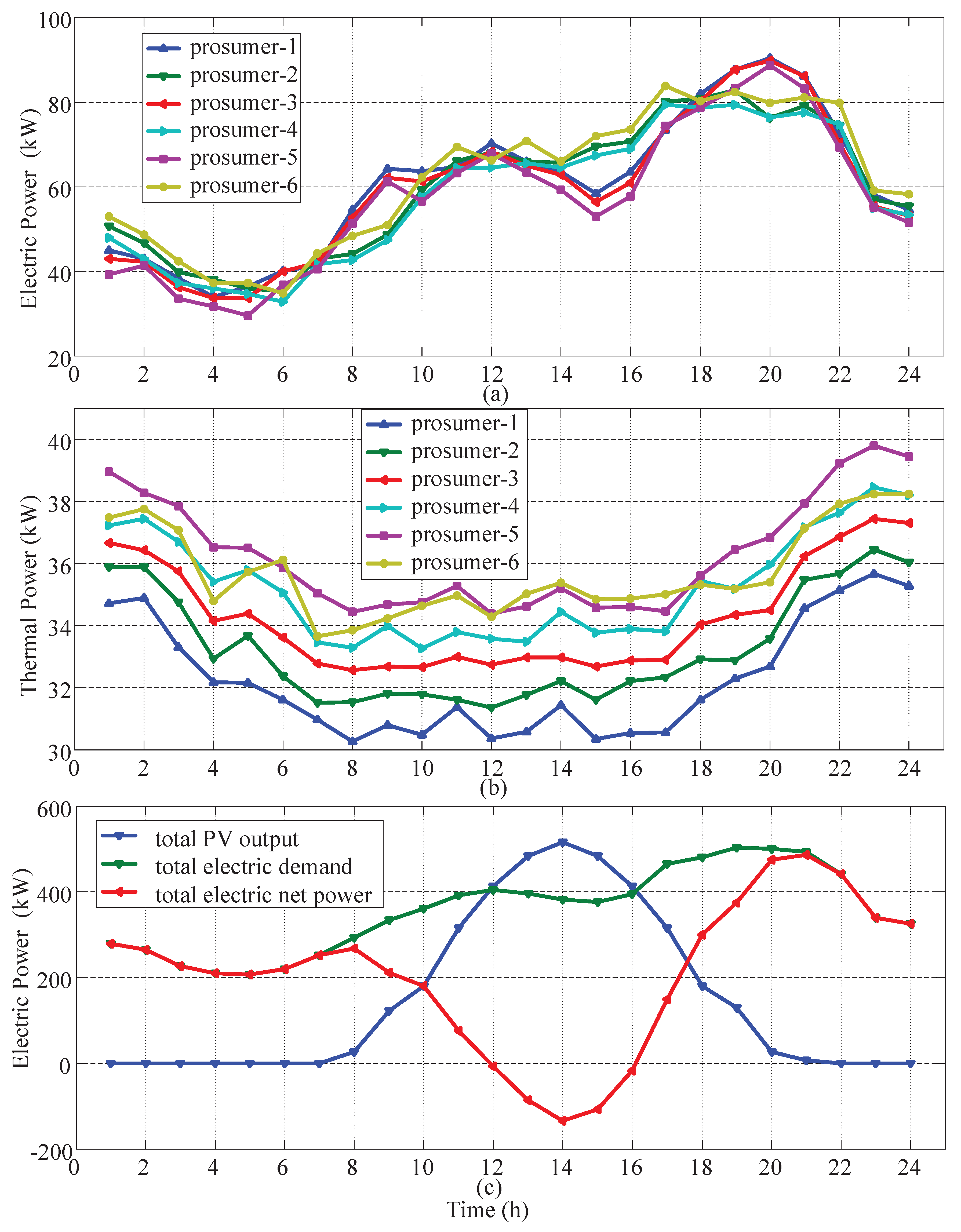
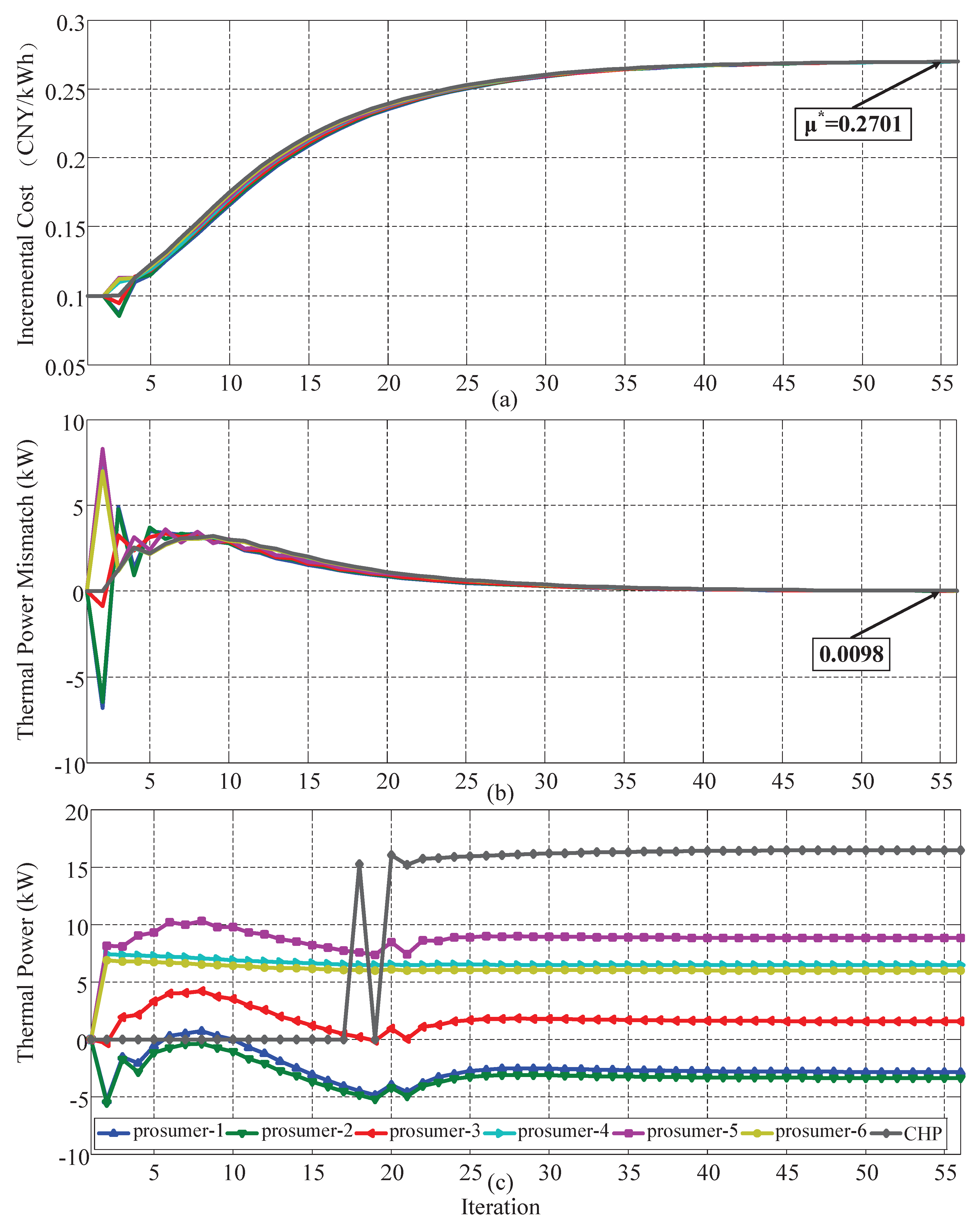
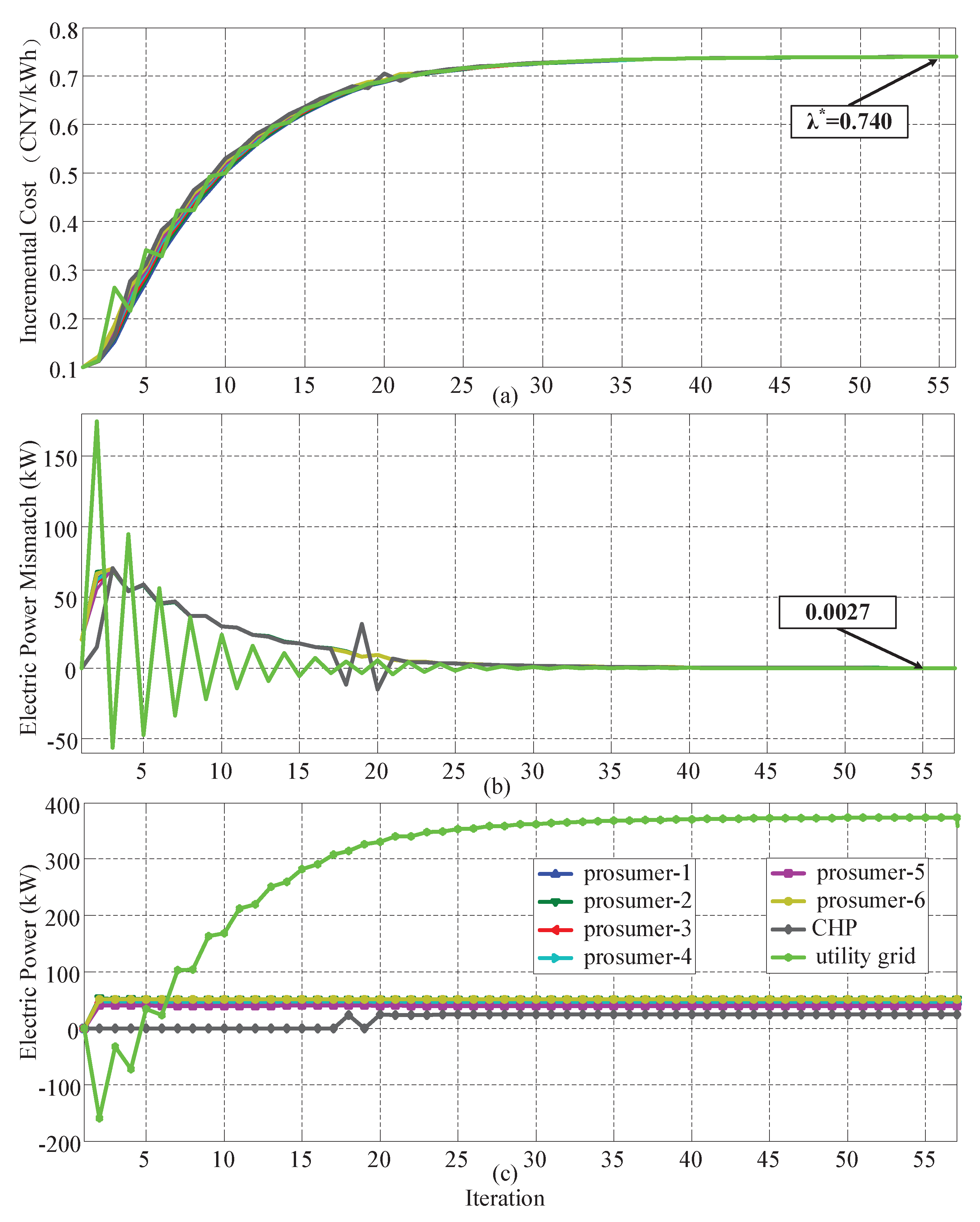
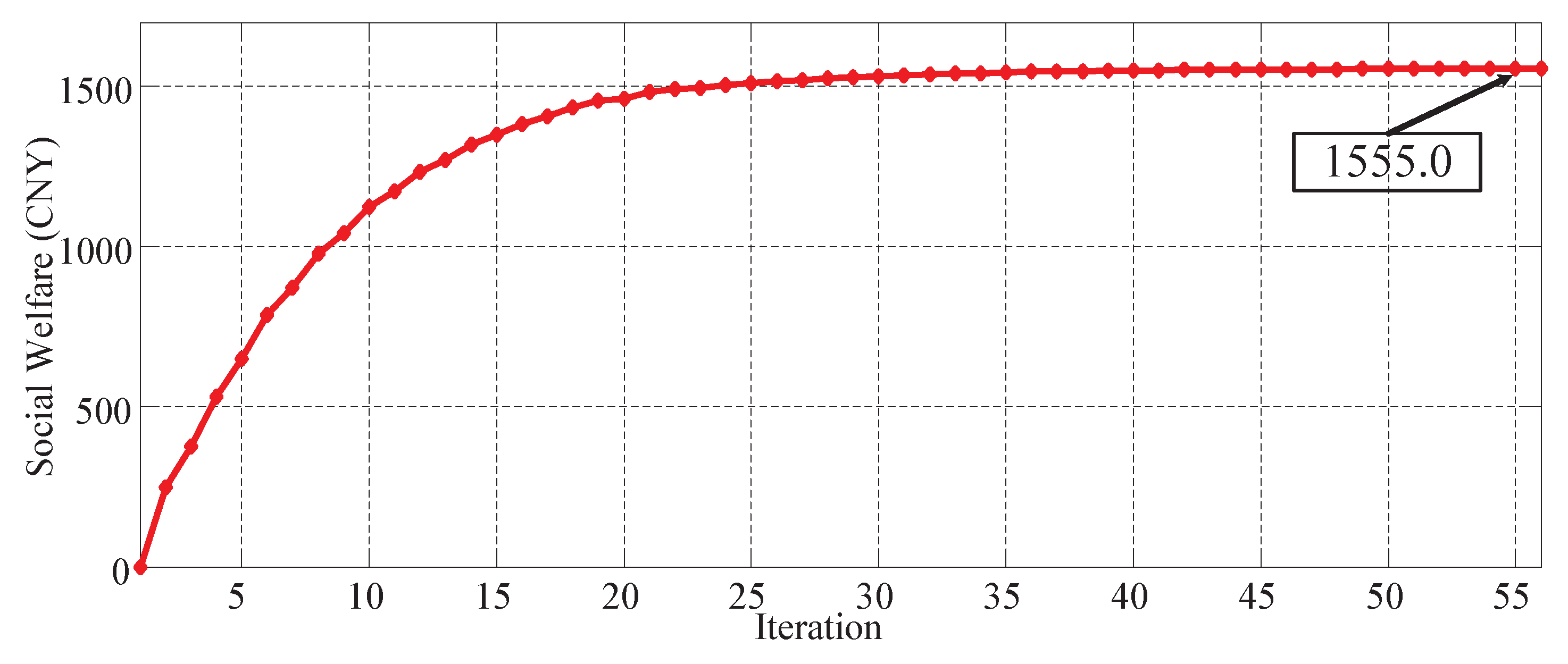
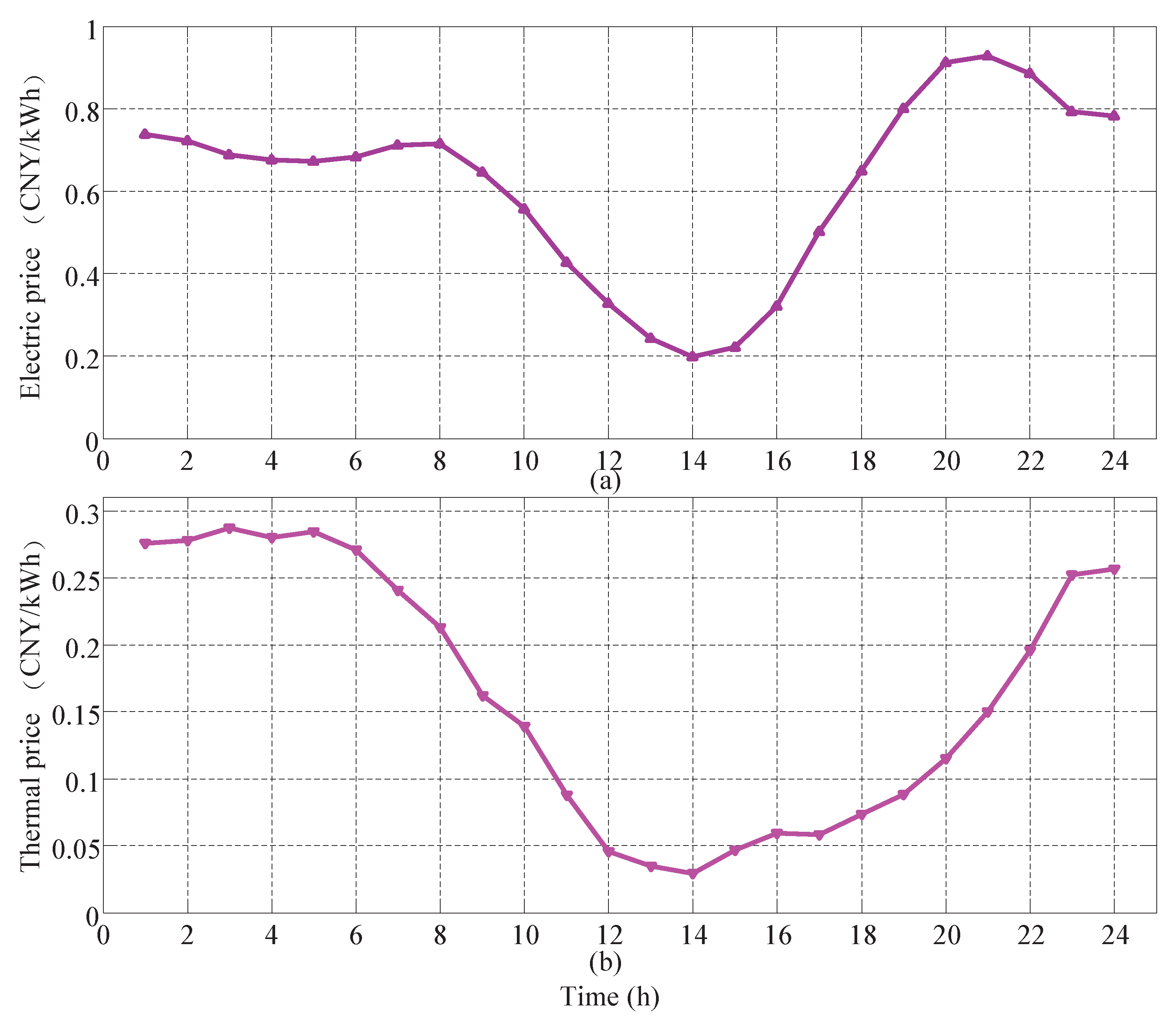
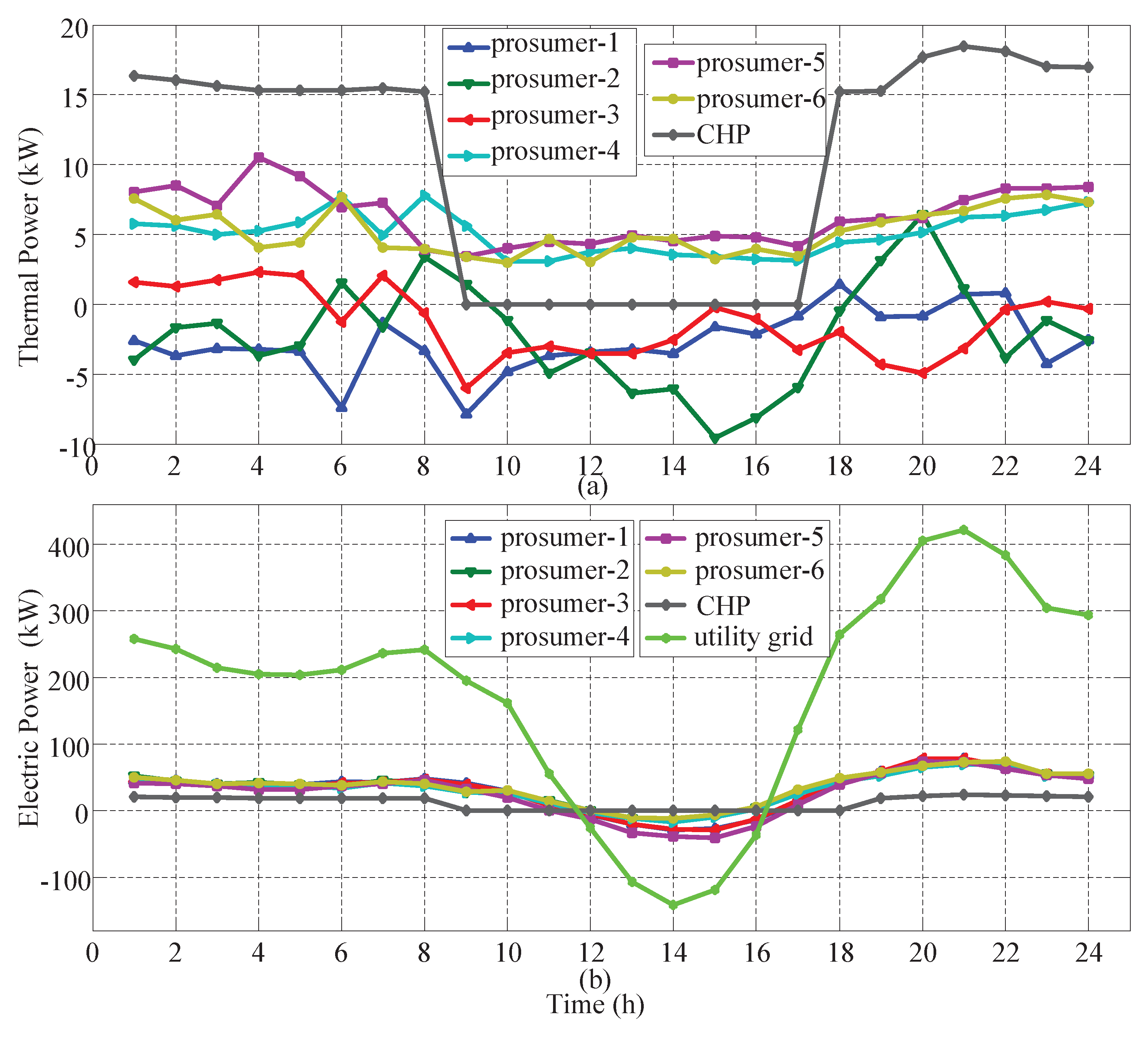
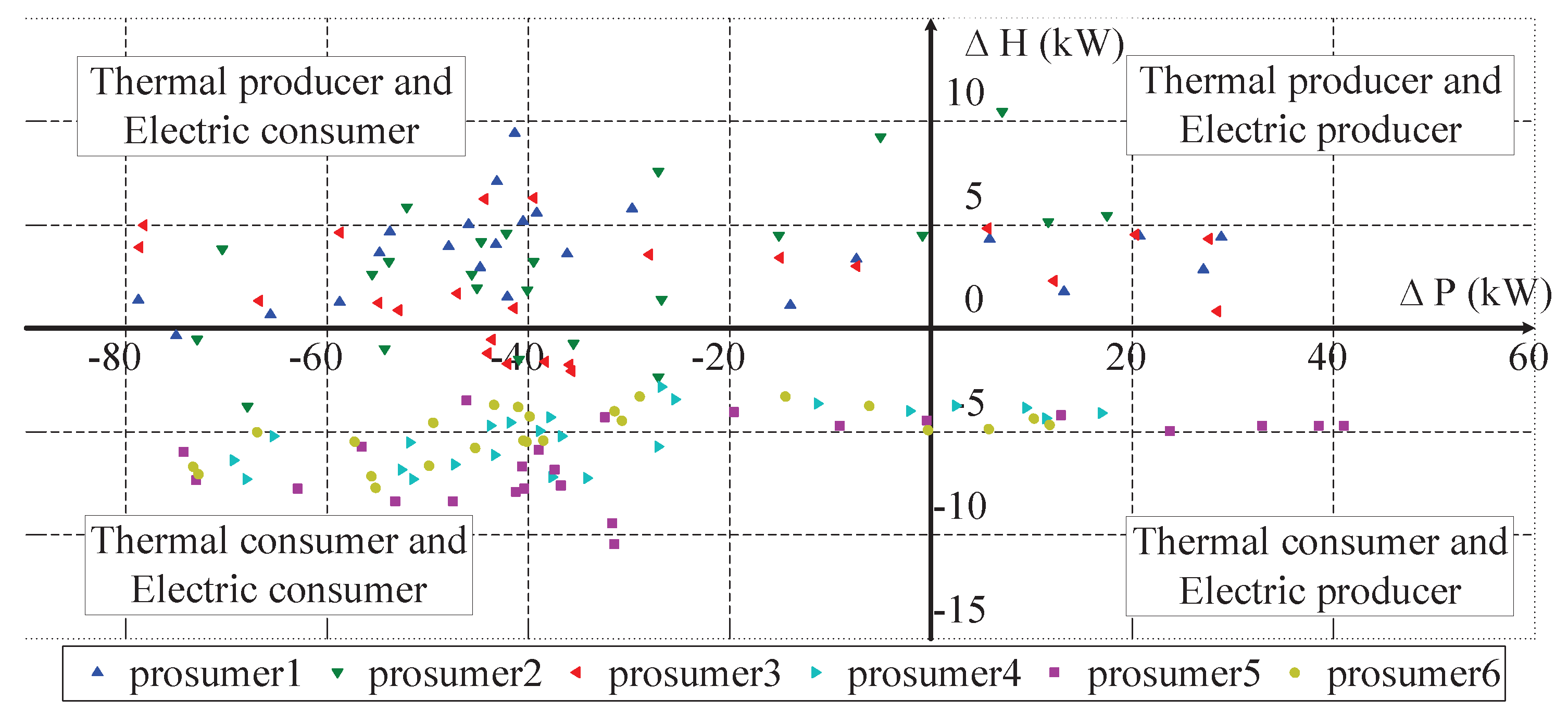
| Participant | Parameters | Value |
|---|---|---|
| Utility grid | Cost coefficients | a = 0.00059, b = 0.302, c = 0 |
| Capacity | [−500, 1000] (kW) | |
| CHP | Cost coefficients | = 0.03395, = 4.6425, = 0.00442 |
| = 1.345, = 0.00384, = 0.004 | ||
| Efficiency | = 0.3441, = 0.80 | |
| Capacity | 50 (kW) | |
| PVT-HP prosumer | COP | 3 |
| Coefficients of comfort | (0.03–0.055), (0.025–0.1) | |
| Capacity of heat pump | 15 (kW) |
© 2018 by the authors. Licensee MDPI, Basel, Switzerland. This article is an open access article distributed under the terms and conditions of the Creative Commons Attribution (CC BY) license (http://creativecommons.org/licenses/by/4.0/).
Share and Cite
Liu, N.; Guo, B.; Liu, Z.; Wang, Y. Distributed Energy Sharing for PVT-HP Prosumers in Community Energy Internet: A Consensus Approach. Energies 2018, 11, 1891. https://doi.org/10.3390/en11071891
Liu N, Guo B, Liu Z, Wang Y. Distributed Energy Sharing for PVT-HP Prosumers in Community Energy Internet: A Consensus Approach. Energies. 2018; 11(7):1891. https://doi.org/10.3390/en11071891
Chicago/Turabian StyleLiu, Nian, Bin Guo, Zifa Liu, and Yongli Wang. 2018. "Distributed Energy Sharing for PVT-HP Prosumers in Community Energy Internet: A Consensus Approach" Energies 11, no. 7: 1891. https://doi.org/10.3390/en11071891





